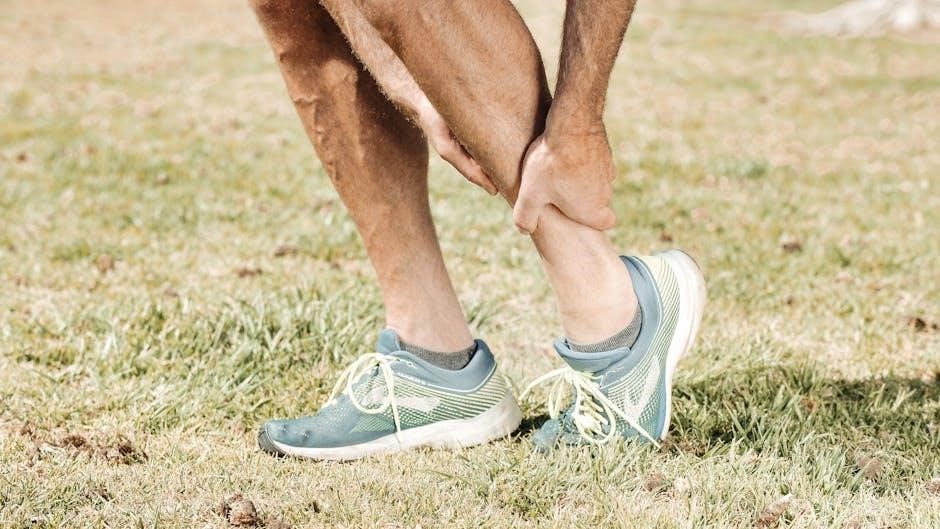The pectoralis major muscle plays a crucial role in movements like pushing, throwing, and chest stabilization. Originating from the sternum and clavicle, it connects to the humerus, enabling flexion and adduction. Pectoral strains often occur during bench pressing or overhead activities, highlighting the importance of proper form and strengthening exercises to prevent injuries and maintain chest functionality.
1.1. Understanding the Pectoralis Major Muscle
The pectoralis major muscle is a fan-shaped muscle located in the chest, playing a vital role in movements such as arm extension, flexion, and rotation. It consists of two parts: the sternal head (larger) and the clavicular head (smaller), both converging to attach to the humerus; This muscle is essential for pushing movements, such as bench pressing, and stabilizes the shoulder joint during activities. Its functionality is closely linked to shoulder and chest mobility, making it prone to strains during intense exercises or overuse. Understanding its anatomy is crucial for effective rehabilitation and preventing future injuries, especially in athletes or individuals engaged in weight training.
1.2. Importance of Pectoral Muscles in Movement and Stability
The pectoral muscles, particularly the pectoralis major, are vital for movements like pushing, throwing, and lifting. They stabilize the shoulder joint and assist in actions requiring chest expansion, such as swimming or climbing. Strength and flexibility in these muscles are essential for athletes and individuals engaged in physical labor, as they prevent injuries and enhance performance. Weakness or imbalances in the pectorals can lead to poor posture and reduced mobility, emphasizing the need for targeted exercises to maintain functionality and avoid strains during everyday or athletic activities.
Causes and Symptoms of Pectoral Strains
Pectoral strains often result from overstretching during weight training, such as bench pressing, causing pain, swelling, and limited chest movement. Symptoms include muscle soreness and reduced strength.
2.1. Common Scenarios Leading to Pectoral Strains
Pectoral strains frequently occur during weightlifting, particularly bench pressing, when the pectoralis major muscle is stretched excessively. Activities involving heavy pushing or overhead movements also contribute. Poor form during exercises like lat pull-downs or pec flys can lead to overstretching. Sudden contractions or direct blows to the chest may cause microtears. Overtraining or inadequate warm-ups increase the risk. Symptoms often include sharp pain, swelling, and limited range of motion. These scenarios highlight the importance of proper technique and gradual strengthening to prevent injuries.
2.2. Identifying Symptoms of a Pectoral Injury
Common symptoms of a pectoral injury include sharp pain during activities like bench pressing or overhead movements. Swelling and bruising in the chest area may develop, along with limited arm mobility. Weakness or tenderness in the pectoral muscle is often present. Pain may worsen with specific movements, such as pushing or stretching the chest; In severe cases, a tearing sensation or complete loss of strength can occur. These symptoms can range from mild discomfort to debilitating pain, depending on the strain’s severity. Proper identification of these signs is crucial for early treatment and recovery.

Immediate Treatment and Care for Pectoral Strains
Immediate treatment involves the RICE method: rest, ice, compression, and elevation to reduce pain and swelling. Pain relief with NSAIDs and immobilization may be recommended. Avoid activities that worsen the strain and seek professional evaluation for proper diagnosis and care.
3.1. RICE Method (Rest, Ice, Compression, Elevation)

The RICE method is the cornerstone of immediate care for pectoral strains. Rest involves avoiding activities that exacerbate the injury. Applying ice for 15-20 minutes every 1-2 hours reduces inflammation and pain. Compression with an elastic bandage helps minimize swelling. Elevation of the affected arm above heart level promotes blood flow and accelerates healing. These steps are crucial in the first 48-72 hours post-injury to prevent further damage and support the body’s natural repair processes, ensuring optimal recovery and reducing the risk of complications.
3.2. Pain Management and Initial Recovery Strategies
Managing pain and initiating recovery involves a combination of rest, analgesics, and controlled movements. Isometric exercises, such as external rotations at neutral positions, can be introduced early to maintain muscle strength without exacerbating the strain. Gentle stretching and controlled mobility exercises help restore function gradually. Avoiding movements that cause sharp pain is crucial to prevent further injury. Pain should guide activity levels, with a focus on low-intensity exercises to promote healing. Consulting a physical therapist can provide personalized strategies to address the severity of the strain and ensure a safe, effective recovery process.

Rehabilitation Phases for Pectoral Strains
Rehabilitation progresses through three phases: acute (0-6 weeks), intermediate (7-12 weeks), and advanced (13+ weeks). Each phase focuses on pain management, strengthening, and functional recovery, ensuring safe progression.
4.1. Phase 1: Acute Phase (Weeks 0-6)
The acute phase focuses on reducing pain and inflammation through immobilization and gentle exercises. Patients often use slings to immobilize the affected arm, minimizing movement. Submaximal isometrics, such as external rotations and prone rows, are introduced to maintain muscle activation without overloading. These exercises target the pectoralis major in a shortened position, avoiding full elongation to prevent further strain. Pain-free isometric holds and light stretching are also incorporated to promote healing and maintain range of motion. This phase lays the foundation for gradual strengthening in subsequent phases, ensuring proper tissue repair and readiness for more intense rehabilitation efforts.
4.2. Phase 2: Intermediate Strengthening (Weeks 7-12)
During this phase, intermediate strengthening exercises are introduced to enhance functional strength and motor control. Seated pec fly with free weights and lat pull-downs (front grip to sternum, avoiding excessive extension) are commonly used. Supine modified pec fly with light weights, focusing on elbow straight and bent positions, is also incorporated. Behind-the-back internal rotations and prone rows are added to strengthen the pectoralis major without overloading. These exercises are performed 1-3 times weekly, provided they do not cause pain. Progression focuses on increasing resistance and ensuring proper form to prepare for advanced exercises in the next phase, promoting muscle balance and stability.
4.3. Phase 3: Advanced Strengthening and Functional Training (Weeks 13+)
In the final phase, advanced exercises focus on maximizing strength, endurance, and functional movement. Plyometric exercises and dynamic chest presses are introduced to enhance power. Sport-specific drills mimic real-world movements, improving agility and coordination. Push-ups, starting with wall-assisted and progressing to floor push-ups, are integral for chest activation. Resistance bands and advanced pectoral exercises, like dumbbell chest presses and incline bench presses, are incorporated to target muscle imbalances. Functional training emphasizes proper form and explosive power, preparing the individual for unrestricted activity. The goal is to restore pre-injury performance levels while ensuring long-term durability through consistent strength and mobility work.
Essential Rehab Exercises for Pectoral Strains
Effective pectoral strain rehabilitation incorporates a variety of exercises to restore strength, flexibility, and function. These include isometric holds, seated chest flys, and prone row exercises to target specific muscle groups, ensuring a balanced recovery and minimizing the risk of further injury.
5.1. Isometric Exercises for Early Recovery
Isometric exercises are a cornerstone of early recovery for pectoral strains, as they promote strength without joint movement. These exercises, such as chest presses against a wall or hands-together pushes, help maintain muscle activation and endurance. They are particularly effective in the acute phase, as they minimize strain on the injured muscle. By focusing on controlled contractions, individuals can gradually rebuild strength and stability. Progression to neutral or shortened positions is recommended to avoid excessive elongation of the muscle-tendon unit. Consistency and proper form are key to ensuring these exercises contribute effectively to the healing process and prevent further injury.
5.2. Seated and Supine Pectoral Fly Exercises
Seated and supine pectoral fly exercises are essential for restoring strength and flexibility in the chest muscles during rehabilitation. Seated pec fly exercises involve using free weights or cables to target the pectoralis major, promoting controlled movement and minimizing strain. Supine modified pec fly exercises, performed with elbows straight or bent, are ideal for progressing from light resistance to more challenging loads. These exercises are typically introduced in the intermediate phase of recovery, helping to restore normal movement patterns and improve muscle endurance. Proper form, such as avoiding excessive extension, is crucial to prevent re-injury and ensure effective rehabilitation.
5.3. Lat Pull-Down Variations for Pectoral Strengthening
Lat pull-down variations are highly effective for strengthening the pectoral muscles without putting excessive strain on the injured area. Using a front grip with the bar pulled towards the sternum helps target the chest muscles while engaging the lats. This exercise is particularly beneficial in the intermediate and advanced phases of rehabilitation, as it allows for controlled resistance without overstretching. Proper form, such as avoiding excessive extension and maintaining a neutral spine, is crucial to maximize effectiveness and prevent further injury. Incorporating lat pull-downs into a rehab routine can enhance muscle balance and restore functional strength, aiding in a successful return to full activity.
5.4. Prone Row and External Rotation Exercises
Prone row exercises are excellent for targeting the pectoral muscles while engaging the scapular stabilizers, promoting balanced strength. Lie on a firm surface with a pillow under the chest, arms extended forward. Perform rows by pulling arms back, squeezing shoulder blades together, and holding briefly. External rotation exercises, such as prone external rotation, enhance shoulder mobility and chest muscle function. These exercises are introduced in later rehab phases to restore proper movement patterns and strength. They are crucial for preventing future injuries and improving overall upper body mechanics, ensuring a safe return to activities like weight training or sports.

Returning to Sport and Activity
Returning to sport requires gradual progression, ensuring pain-free movements and full strength. Sport-specific training is introduced to mimic game conditions, promoting a safe and effective comeback.
6.1. Criteria for Safe Return to Sports
Return to sport is typically allowed 6-9 months post-injury, provided the athlete demonstrates pain-free movement, full strength, and proper functional mobility. Sport-specific training is introduced gradually, mimicking game conditions to ensure readiness. Clearance from a healthcare professional is essential, confirming the athlete can perform without discomfort or risk of re-injury. Progression is based on individual recovery, with a focus on maintaining proper form and technique to prevent future strains. This phased approach ensures a safe and effective transition back to athletic activities.
6.2. Progressive Loading and Sport-Specific Training
Progressive loading involves gradually increasing exercise intensity to rebuild strength and endurance. Sport-specific training mimics the athlete’s movements, ensuring functional recovery. Examples include modified push-ups, plyometrics, and dynamic exercises. These activities are introduced only when pain-free strength and mobility are achieved. Monitoring for any discomfort is crucial to avoid setbacks. The goal is to replicate game conditions while maintaining proper form and technique. This phase bridges rehabilitation with competitive performance, ensuring the athlete is prepared for the demands of their sport. Tailored programs focus on the specific movements and stresses of the athlete’s discipline, promoting a seamless return to activity.
Consistent rehabilitation, proper form, and professional guidance ensure effective recovery from pectoral strains, preventing reinjury and restoring full functionality for daily activities and athletic performance.
7.1. Summary of Key Rehabilitation Strategies
Effective pectoral strain rehabilitation involves a structured approach, starting with the RICE method to reduce inflammation. Isometric exercises and gentle mobilization are introduced in the acute phase, progressing to strengthening exercises like push-ups and lat pull-downs. Pain management is crucial, with a focus on avoiding aggravating movements. Functional training and sport-specific drills are incorporated in later stages to restore muscle balance and coordination. Consistency and adherence to a phased program ensure optimal recovery and minimize the risk of reinjury. Professional guidance tailors the rehab plan to individual needs, promoting a safe and efficient return to activity.
7.2. Importance of Consistency and Professional Guidance
Consistency is vital in pectoral strain rehabilitation to ensure steady progress and prevent setbacks. A well-structured routine, adhered to regularly, fosters muscle repair and strength. Professional guidance from physical therapists or trainers ensures exercises are performed safely and effectively, minimizing injury recurrence. They tailor programs to individual needs, addressing specific deficits and promoting proper form. Without consistency and expert oversight, recovery may plateau or lead to chronic issues. A supervised approach also builds patient confidence, encouraging adherence to rehabilitation protocols and facilitating a successful return to normal activities or sports.
